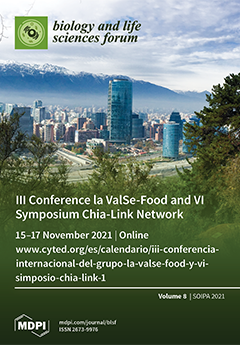Native to South America, the
Sicana sp. fruits, known in Paraguay as “kurugua”, belongs to the Cucurbit family and is almost extinct in the region. The aim of this study was to determine the physicochemical characteristics, composition and antioxidant activity of “kurugua” with
[...] Read more.
Native to South America, the
Sicana sp. fruits, known in Paraguay as “kurugua”, belongs to the Cucurbit family and is almost extinct in the region. The aim of this study was to determine the physicochemical characteristics, composition and antioxidant activity of “kurugua” with reddish peel color. The determinations were made by official and regional standardized methodologies on fresh weight (FW). The pulp has an alkaline pH (7.41 ± 0.11), and its main components are carbohydrates (9.44 ± 0.45 g·100 g
−1), followed by dietary fiber (1.74 ± 0, 04 g·100 g
−1), as minor proteins (0.53 ± 0.05 g·100 g
−1) and lipids (0.08 ± 0.01 g·100 g
−1). On the evaluated antioxidants compounds, they were higher in peel than in pulp as; total phenols (279.2 ± 12.1, 55.7 ± 10.3 mg of GAE·100 g
−1), Vitamin C (9.67 ± 0.09, 7.84 ± 1.71 mg·100 g
−1) and beta-carotene (0.37 ± 0.03, 0.19 ± 0.01 mg·100 g
−1), respectively. Fresh seeds have a high moisture content (38.8%), dietary fiber (40.2%) and lipids (11.74%), they mineral composition showed a high content of Mg and Ca and a high content of micronutrients such as Cu, Mn, Fe and Zn, which can represent a great contribution to the daily requirements of the diet. The red kurugua fruits are a natural source of nutritious and bioactive compounds beneficial to health, with multiple potential applications in foodstuff, which should be promoted in healthy dietary guidelines for the benefit of the populations.
Full article



